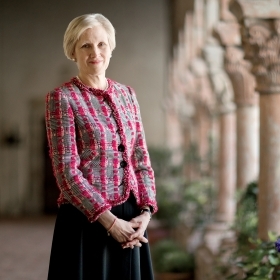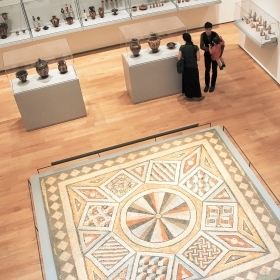Hundreds of alumnae have worked in museums around the world, engaging members of their communities through art, science, and objects. We spoke with two Wellesley curators about their lives, art, and why museums matter, now more than ever.
Hundreds of alumnae have worked in museums around the world. We spoke with two Wellesley curators about their lives, art, and why museums matter, now more than ever.

Leslie Guy ’86
Chief Curator, DuSable Museum of African American History, Chicago

Photo by AP Photo/Tae-gyun Kim
Leslie Guy, who trained originally as an art conservator, was up close and personal with the work of an Old Master when she had a realization that set the course of the rest of her career.
“I had this … I don’t know whether it was an epiphany or an existential crisis,” she says. “I was working on this painting, and it was a gorgeous painting, and I was really enjoying the process. And then it struck me that, wow, I’m sitting here working really diligently on the work of a man who would never have recognized me as a person. … How am I spending my time? And what systems am I upholding by doing what I’m doing? … That led me to do ethnographic conservation and to concentrate on collections that were basically underrepresented.”
Guy wound up working at the African American Museum in Philadelphia as its conservator and curator of collections, which led her into full-time curation, “which is a whole different way of thinking,” she says. “What I have found the most rewarding about the work I’ve been doing is when I can actually connect it to the communities, and it has real impact upon people’s lives. Objects and exhibitions can be really powerful.”
One of the most impactful exhibits she’s worked on, she says, is Legendary, which showcased the work of photographer Gerard Gaskin, who documented the black and Latinx queer ballroom scene for some 20 years. The timing was fortuitous, she explains, as Philadelphia was celebrating a gay-rights protest that preceded Stonewall, and it was also the summer that the Supreme Court ruled that state-level bans on same-sex marriage are unconstitutional. “We were able to do a lot of community outreach through the exhibition. I was able to document people’s experience of either coming out to their families, or their ballroom experiences,” she says.
Last year, Guy moved to Chicago to become the chief curator of the DuSable Museum of African American History. “What drew me to the DuSable is that it is the oldest independent African-American museum in the country,” says Guy. It was founded in 1961 by teacher and art historian Margaret Burroughs, who also helped found the South Side Community Arts Center and was a poet and artist herself. This year marks the founder’s centennial, and Guy has been thinking about how to tell Burroughs’ story through the museum.
“It really is about community-based work, at the heart of the matter,” she says. “Everybody here I meet, they have a story about her and how she touched their lives, and the impact that she had in large and small ways, in all walks of life. I think it’s really important that museums close the distance between themselves and their audiences. … In this day and age, people don’t want to be told what it is they should know. They want to be participating in what it is that they want to learn, and you have to be able to listen and get feedback.”
Ann Yonemura ’69
Senior Associate Curator of Japanese Art, Freer Gallery of Art and the Arthur M. Sackler Gallery, Washington, D.C.

Photo by Bruce Weller
When asked to name her favorite piece in the Freer Gallery of Art and the Arthur M. Sackler Gallery, where she is senior associate curator of Japanese art, Ann Yonemura ’69 laughs at the impossibility of choosing just one. But, she concedes, there is one object that moved her extraordinarily—a hand scroll of calligraphy by 13th-century Japanese Emperor Fushimi.
“It is heavily decorated with flecks of silver and gold, and then it has the emperor’s own written poetry,” says Yonemura, a third-generation Japanese-American who grew up in Berkeley, Calif. “My mother’s mother was from a samurai family, which would be a warrior-class family. But her husband was not—he was from a farmer family. And my father’s family were farmers. And so as I was looking at that scroll, I thought, it’s only because of the historical changes that have come about in the modern world with the establishment of museums, with the movement of objects out of highly private, elite collections into these museums, that I would even be looking at this. … It was really the first time that I realized that what seemed like a perfectly routine research examination was so extraordinary, because 150 years ago, it couldn’t have been me,” she says.
Yonemura recently marked her 40th anniversary of service at the Freer Gallery. It opened in 1923, the first art museum on the Smithsonian campus, built around Charles Lang Freer’s collection of Asian and American art. The Arthur M. Sackler Gallery, which is connected to the Freer through an underground tunnel, opened in 1987. “The Sackler now has a very substantial collection of prints that range from the 18th through the 20th century. … So I’ve worked in prehistory all the way to the 20th century, but my hard skill remains in the period of the 14th to 16th century, where I first focused my studies. … I’m always glad when I can go back to that period. It’s like going home,” she says.
The history of the Freer and the Sackler and the nature of their collections encapsulates what is important about having Asian art exhibited outside of Asia, Yonemura says.
“It offers an opportunity for people who haven’t necessarily seen this type of art before to have an experience that’s unlike anything that they’ve had before, and through that experience, to develop an interest, perhaps, and an intuitive understanding of the achievements of another civilization, another culture,” she says. “I think—particularly in this time that we find ourselves in—to have the opportunity to open our minds to the achievements of people who don’t share our ethnic background, perhaps, who come from a different part of the world where we don’t speak their language, to be able to use our eyes and our minds to move a little bit beyond our everyday experiences, is really valuable. It’s part of what makes us human.”
Lisa Scanlon Mogolov ’99 is a senior associate editor of Wellesley magazine.
Metropolitan Museum of Art photograph by Amos Chan


